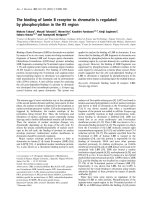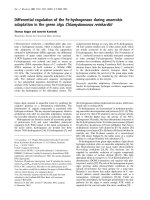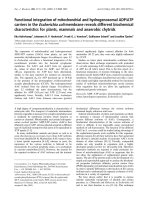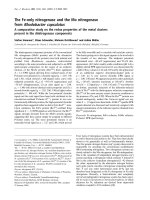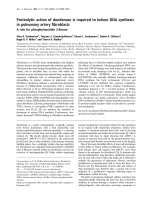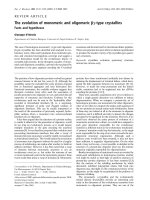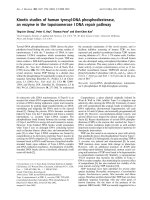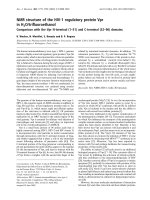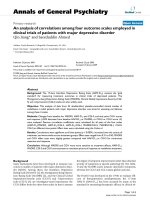Báo cáo y học: "Users'''' perspectives of barriers and facilitators to implementing EHR in Canada: A study protocol" pot
Bạn đang xem bản rút gọn của tài liệu. Xem và tải ngay bản đầy đủ của tài liệu tại đây (276.92 KB, 8 trang )
BioMed Central
Page 1 of 8
(page number not for citation purposes)
Implementation Science
Open Access
Study protocol
Users' perspectives of barriers and facilitators to implementing
EHR in Canada: A study protocol
Marie-Pierre Gagnon*
1,2
, Nicola Shaw
3
, Claude Sicotte
4
, Luc Mathieu
5
,
Yvan Leduc
6
, Julie Duplantie
1
, James Maclean
7
and France Légaré
1,6
Address:
1
Research Center of the Centre Hospitalier Universitaire de Québec, Québec, Canada,
2
Department of Nursing, Université Laval, Québec,
Canada,
3
Faculty of Medicine, University of Alberta, Alberta, Canada,
4
Department of Health Management, Université de Montréal, Montréal,
Canada,
5
Department of Nursing, Université de Sherbrooke, Québec, Canada,
6
Department of Family Medicine, Université Laval, Québec, Canada
and
7
Innovation and Adoption Committee, Canada Health Infoway, Canada
Email: Marie-Pierre Gagnon* - ; Nicola Shaw - ;
Claude Sicotte - ; Luc Mathieu - ; Yvan Leduc - ;
Julie Duplantie - ; James Maclean - ; France Légaré -
* Corresponding author
Abstract
Background: In Canada, federal, provincial, and territorial governments are developing an ambitious
project to implement an interoperable electronic health record (EHR). Benefits for patients, healthcare
professionals, organizations, and the public in general are expected. However, adoption of an
interoperable EHR remains an important issue because many previous EHR projects have failed due to the
lack of integration into practices and organizations. Furthermore, perceptions of the EHR vary between
end-user groups, adding to the complexity of implementing this technology. Our aim is to produce a
comprehensive synthesis of actual knowledge on the barriers and facilitators influencing the adoption of
an interoperable EHR among its various users and beneficiaries.
Methods: First, we will conduct a comprehensive review of the scientific literature and other published
documentation on the barriers and facilitators to the implementation of the EHR. Standardized literature
search and data extraction methods will be used. Studies' quality and relevance to inform decisions on EHR
implementation will be assessed. For each group of EHR users identified, barriers and facilitators will be
categorized and compiled using narrative synthesis and meta-analytical techniques. The principal factors
identified for each group of EHR users will then be validated for its applicability to various Canadian
contexts through a two-round Delphi study, involving representatives from each end-user groups.
Continuous exchanges with decision makers and periodic knowledge transfer activities are planned to
facilitate the dissemination and utilization of research results in policies regarding the implementation of
EHR in the Canadian healthcare system.
Discussion: Given the imminence of an interoperable EHR in Canada, knowledge and evidence are
urgently needed to prepare this major shift in our healthcare system and to oversee the factors that could
affect its adoption and integration by all its potential users. This synthesis will be the first to systematically
summarize the barriers and facilitators to EHR adoption perceived by different groups and to consider the
local contexts in order to ensure the applicability of this knowledge to the particular realities of various
Canadian jurisdictions. This comprehensive and rigorous strategy could be replicated in other settings.
Published: 9 April 2009
Implementation Science 2009, 4:20 doi:10.1186/1748-5908-4-20
Received: 9 January 2009
Accepted: 9 April 2009
This article is available from: />© 2009 Gagnon et al; licensee BioMed Central Ltd.
This is an Open Access article distributed under the terms of the Creative Commons Attribution License ( />),
which permits unrestricted use, distribution, and reproduction in any medium, provided the original work is properly cited.
Implementation Science 2009, 4:20 />Page 2 of 8
(page number not for citation purposes)
Background
Although the electronic health record (EHR) is a clear pri-
ority for policy makers in Canada [1], this country is still
lagging behind other industrialized countries in that
respect [2]. Federal, provincial, and territorial govern-
ments, in partnership with Canada Health Infoway ('Info-
way'), are currently developing an ambitious project
consisting in the implementation of a pan-Canadian
interoperable EHR, that is, an EHR that has the ability to
work with other information systems across organizations
[3]. Infoway's program focuses on implementing a net-
work of interoperable EHR solutions in Canada linking
medical clinics, hospitals, pharmacies, and other points of
care. This integrated patient-centred health record pro-
vides a longitudinal view of an individual's key health his-
tory and care, including physician visits, hospitalizations,
diagnostic images and reports, laboratory test results, pre-
scribed drugs, and immunizations. It will give authorized
healthcare providers rapid access to patients' complete,
up-to-date health information to support clinical deci-
sion-making and case management.
The EHR is considered as the key to the integration of var-
ious tools (e.g., test ordering, electronic prescription, deci-
sion-support systems, digital imagery, telemedicine) that
will enable a safer and more efficient healthcare system
for every Canadian [4-6]. Benefits for patients, healthcare
professionals, organizations and the public in general are
expected. It is argued that the EHR has the potential to fill
the information gaps that are believed to currently com-
promise the quality and productivity of Canada's health-
care system [7]. One of the main benefits reported is the
increased quality of care resulting from patients having
their essential health data accessible to their different pro-
viders [8,9]. Also, the EHR could support empowered cit-
izens to actively take part in decisions regarding their
health, based on relevant disease management programs
[10]. However, as Richard Alvarez, Infoway's President
and CEO, asserts: 'we can only succeed in making elec-
tronic health records a reality if health care providers
adopt the technology. Without their acceptance, our
efforts are futile' [11].
Challenges to implement EHR in a complex healthcare
system
Many previous EHR projects have failed due to the lack of
integration into practices and organizations, thus making
the implementation of EHR a timely and foremost impor-
tant issue [12,13]. A comparative study of EHR adoption
among general practitioners (GPs) in 10 countries
showed that Canadian GPs ranked last [2]. This huge lag
in implementation of EHR points to the need of identify-
ing its contributing determinants from macro-level sys-
temic factors to micro-level individual barriers.
Perceptions of EHRs may vary between health profession-
als groups, adding to the complexity of implementing this
technology in a pluralist healthcare system. Furthermore,
discrepancies between patients' and professionals' per-
spectives may obstruct the adoption and use of EHR [9].
Given the lack of current evidence on effective strategies to
implement interoperable EHR, there is an urgent need to
synthesise knowledge regarding the integration of this
complex and innovative technology into current practices.
Therefore, it is imperative to conduct a knowledge synthe-
sis of the factors that could affect the implementation of
an interoperable EHR in the healthcare system given the
multiplicity of providers involved. Furthermore, perspec-
tives of patients and the public in general regarding an
interoperable EHR have rarely been addressed and deserve
specific attention.
EHR and patients and public participation
As the role of patients in making decisions regarding their
health and influencing healthcare policies increases, their
expectations and demands will be a major force in driving
the use of EHR [14-16]. While patient safety is 'a corner-
stone of Infoway's activities' [5], patient and public partic-
ipation in decisions regarding EHR implementation has
been limited. Nevertheless, literature supports the bene-
fits of patients' involvement in the development of EHR.
For instance, patients accessing their primary care EHR in
the UK had an increased perception of security and pri-
vacy [17]. Patients also expressed their interest in having
more features available on their EHR, but were concerned
about the nature of the information accessible to different
healthcare providers. The EHR aims to collect information
to allow for 'cradle to the grave' treatment [18]; thus,
health consumers are major players in ensuring that this
will come to fruition [19]. A survey has shown that the
Canadian population was ready for a greater use of health-
care Information and Communication Technologies
(ICT), but that citizens had several doubts and concerns
that should be taken into account in order to achieve the
full potential of these technologies [20].
Gaps in knowledge that this study is addressing
Up to now, studies on the factors that affect EHR imple-
mentation have mostly focused on healthcare profession-
als, especially physicians [21]. A majority of these studies
presented methodological limitations and findings have
been dissonant [22]. Comparisons of the perspectives of
various professional groups (nurses, pharmacists, medical
archivists, managers, et al.) toward the EHR have been
reported in the literature, but this knowledge has not been
synthesized [23]. In a healthcare system that tends toward
greater interdisciplinarity [24], it is critical to acknowledge
the dynamics of each groups of users and their interde-
pendence when introducing the EHR.
Implementation Science 2009, 4:20 />Page 3 of 8
(page number not for citation purposes)
Goal and objectives
We propose a method for developing a comprehensive
and inclusive synthesis of actual knowledge on barriers
and facilitators influencing EHR implementation in order
to conciliate opinions from diverse groups of stakehold-
ers, including patients and the public. This knowledge will
help decision makers elaborate effective strategies to sup-
port the implementation of EHR in Canada by informing
them on the key issues that should be taken into account.
The chief objective of the proposed study is to develop a
novel method for producing a comprehensive and inclu-
sive knowledge synthesis that will ultimately facilitate evi-
dence- and context-based decisions regarding the
implementation of EHR in the healthcare system. The spe-
cific objectives are to: conduct a mixed-method review of
the literature on the barriers and facilitators related to the
adoption of an interoperable EHR among the targeted
groups of users (public, patients, healthcare professionals,
managers); categorize, synthesize, and compare the per-
ceptions of these different groups; underline the adop-
tion/non-adoption factors specific to each professional
group (physicians, nurses, pharmacists) and those specific
to collective and interdisciplinary clinical work; and iden-
tify key issues for interoperable EHR implementation rel-
evant to the specific context of the Canadian healthcare
system. This knowledge synthesis will lead to a proposed
set of strategies for effective implementation of EHR in
Canada by identifying its barriers and facilitators.
Methods
The guiding principle of this knowledge synthesis is its
applicability to answer real challenges that decision mak-
ers face in implementing EHR. The project is divided into
two main phases that will allow: reviewing and synthesiz-
ing relevant literature on barriers and facilitators to imple-
menting the EHR that are perceived by its various end-
users and beneficiaries; and validating these findings for
the implementation of EHR in Canada.
Systematic review of barriers and facilitators to EHR
adoption
During the first phase of the study, a comprehensive
review of the scientific literature (qualitative, quantitative,
and mixed-methods studies) and other published docu-
mentation (technical or 'grey' literature) on the barriers
and facilitators to the implementation of the EHR will be
conducted. Previous reviews and syntheses conducted in
the field of healthcare ICTs [25-30] have guided the elab-
oration of the search strategies.
Sources of data
Standardized literature searches will be conducted on all
relevant databases (MEDLINE, Ovid, Cochrane Central
Register for Controlled Trials, Campbell Collaboration
Register for Controlled Trials, Current Content, Science
Citation Index, Social Sciences Citation Index, LISA,
CINAHL, PsychINFO, EMBASE, Electronics and Commu-
nications Abstracts, Computer and Information Systems
Abstracts, ERIC, ProQuest). The sensibility of the search
strategy will be validated by ensuring that all relevant key
articles identified by all team members (including deci-
sion makers and researchers) are retrieved. Relevant refer-
ences from studies found through the above routes will be
followed up and obtained for assessment. Other literature
will be identified through internet search engines and
government websites. Hand searches will be performed in
specialized scientific journals with a focus on healthcare
ICT and implementation research. Finally, publications
citing the selected articles as well as other articles from
authors of the selected articles will be searched through
the ISI Science Citation Index. Specialized email lists will
be used to contact experts in the field of EHR for unpub-
lished studies. The diversity of interests and expertise
among researchers of the team and their respective net-
works will ensure that all relevant literature is covered.
Inclusion/exclusion criteria
Type of studies
All rigorous quantitative, qualitative, and mixed-methods
designs will be considered. We will use specific scales to
assess the quality of each type of design, based on a recent
tool that proposes specific criteria for assessing quantita-
tive (experimental and observational), qualitative, and
mixed-method designs [31]. The following Studies pub-
lished in all languages will be included.
Participants
Professional groups included are: physicians, nurses,
pharmacists, medical archivists, and managers given that
they are potentially the greatest users of the EHR in the
Canadian healthcare system [32]. Studies aimed at EHR
implementation from the perspectives of patients, health
consumers or the general public will also be included.
Intervention
The implementation of any interoperable EHR will be the
targeted intervention. We will consider 'interoperable'
EHR as long as there is an exchange of health data involv-
ing more that one organization and/or setting of care.
Objective
Included studies must clearly mention a focus on barriers
and/or facilitators to EHR implementation. A structured
data collection process must be clearly described, i.e.,
research strategies and measurement tools in relation to
the study methodology must be present. Thus, studies
reporting unstructured observations, editorials, com-
ments, or position papers will be excluded. Systematic
reviews and meta-analyses will be considered if their main
Implementation Science 2009, 4:20 />Page 4 of 8
(page number not for citation purposes)
focus is on barriers and facilitators to the adoption of
EHR.
Screening and data abstraction
All titles and abstracts will be screened independently by
a team consisting of one of the two principal investigators
(MPG and FL) and a research associate to assess which
studies fit the inclusion criteria. Any discrepancies
between the two reviewers on study inclusion will be
resolved by discussion with other team members. Full text
copies of all potentially relevant papers will be retrieved.
Then, each study will be independently abstracted by two
reviewers. For each group of EHR users identified, barriers
and facilitators will be categorized and compiled using a
validated extraction grid. This grid has been developed by
one of the investigator (FL) [33,34] and combines various
factors that are likely to affect healthcare professionals'
behaviours identified from existing conceptual frame-
works [35-37]. The grid has been validated for a study of
barriers and facilitators to the implementation of shared
decision-making in clinical settings [26]. Specific adapta-
tions will be made to the grid in order to ensure its appli-
cability to studies reporting the perspectives of patients
and citizens toward the EHR. The grid will help organizing
the information by providing a preliminary classification
of the various barriers and facilitators to the adoption of
EHR.
Appraisal of study quality
The quality of all eligible studies will be assessed by the
two independent reviewers using quality criteria specific
to quantitative, qualitative, and mixed-methods designs
[38-40]. Studies that do not meet a minimal quality
threshold on their respective quality scales will be dis-
carded. Any discrepancies in quality ratings will be
resolved by discussion and involvement of an arbitrator
among other team members when necessary. Technical
and grey literature will also be appraised for quality, but
given that there are no consensus criteria for quality for
this literature that we are aware of, studies from these
sources will be considered as complementary to the scien-
tific literature.
Study relevance screening
To ensure their relevance to inform decisions on EHR
implementation, all eligible studies will be assessed by
two independent reviewers representing decision makers.
The four dimensions of user-based relevance proposed by
Saracevic [41] will be used: aboutness (referring to how
well the topic of the study matches the objective of the
review), pertinence, context, and motivation. However, to
the best of our knowledge, there are no specific scales or
checklists available to measure those dimensions. We will
identify criteria through a deliberation process with
twelve to fifteen decision makers (physicians, nurses,
medical archivists, managers and patients, from eastern,
western, and central provinces, as well as territories of
Canada). This unique process will favour interactions
between researchers and decision makers on studies' rele-
vance regarding their use to support real life decisions.
When a consensus on the criteria for each dimension will
be obtained, a scale will be created and face validated with
members of the innovation and adoption committee of
Infoway (where decision makers from all Canadian prov-
inces and territories are represented). This scale will be
used independently by two reviewers among the decision
makers collaborating to the research team to assess the rel-
evance of each study. Any discrepancies in relevance rat-
ings will be resolved by discussion and involvement of
another reviewer where necessary.
Methods for synthesising findings
Findings will be reported using consensual guidelines for
narrative syntheses and meta-analytical techniques [42-
45]. Factors identified will be grouped according to the
underlying theoretical concepts. An iterative analytical
method will be performed, based on transparency and
search for consensus between the reviewers. Thus, other
emergent categories of barriers and facilitators might be
added to the classification grid during the review process.
A narrative synthesis [42,44] will be performed to summa-
rize the evidence from various types of studies. A compar-
ison of the barriers and facilitators to EHR adoption
among the various groups represented will be done using
meta-analytical techniques. Results will be presented
according to each professional groups and health con-
sumers for which barriers and facilitators to the EHR
adoption have been studied. Also, factors that are specific
to interdisciplinary clinical work will be clearly identified.
This synthesis will provide insight on a wide range of con-
ditions that might influence the acceptance, adoption, uti-
lization, and integration of an interoperable EHR in the
healthcare system.
Strategies to ensure methodological rigor
Guidelines from recognized organizations, such as the
Cochrane and the Campbell Collaborations, will be fol-
lowed for ensuring the methodological rigor of this sys-
tematic review. Given the variability in the nature of the
literature that will be assessed through this review, we will
make sure that appropriate criteria are used to assess the
quality of each type of studies (quantitative, qualitative,
and mixed-methods). Both principal investigators have
experience in mixed-methods systematic reviews of
healthcare professionals' behaviours [25,26,34,46,47]
that will help in structuring the synthesis process. Further-
more, the research team combines different types of
expertise that will enable a comprehensive synthesis of the
knowledge on factors affecting the adoption of the EHR
from various perspectives.
Implementation Science 2009, 4:20 />Page 5 of 8
(page number not for citation purposes)
Pan-Canadian Delphi study
To help ensure their contextualization and relevance for
policymaking in the Canadian context [48], findings from
the systematic review will be presented to a large panel of
experts in the second phase of the study. This represents a
novel approach to knowledge synthesis because it aims to
increase the relevance and applicability of scientific evi-
dence for decision makers [48]. A Delphi study [49]
involving representatives from each group will be con-
ducted with the aim of reaching a consensus between
those experts. This type of study is highly recommended
for obtaining opinions from experts who live and work in
different geographic regions and settings [50]. The ano-
nymity of the Delphi process also encourages open and
honest feedback among experts.
Selection and recruitment of the expert panel
The aim of the Delphi study is to obtain opinions from
each group of EHR users representing a variety of exper-
tises and contexts in Canada. As such, 10 to 18 experts
[49] for each group of EHR users will be identified across
Canada through professional associations and corpora-
tions, regional health authorities, and regional EHR team
projects from each province. A list of potential partici-
pants will be created through the contact networks
method [51], with the help of decision makers of the team
and their collaborators. Recruitment of experts will be
done by email. A postcard will also be sent to allow con-
tacting participants who do not have email or do not use
it, to limit possible selection bias. However, participants
must have internet access to be included in the study. The
message will present the study's objectives, the nature of
their implication, and will solicit their participation in the
Delphi study. The message will also provide a link to the
study website (or URL address in the postcard) and give
participants a temporary username.
The Delphi process
The first step of this Delphi study is to develop a pre-test
questionnaire from the findings of the systematic review.
This questionnaire will present the principle barriers and
facilitators that have been reported in the literature for
each group of EHR users. The selection of items will be
based on their relative importance in the literature. In gen-
eral, items mentioned by 15% or more of the studies will
be kept, based on content analysis techniques to identify
salient beliefs in the construction of questionnaires [52].
Experts representing groups of EHR users will validate this
questionnaire to ensure the good understanding of the
questions and to evaluate the time needed to complete it.
After this pre-test, a final questionnaire will be prepared
and made accessible electronically on the secure website.
All potential participants will be sent an information
sheet about the project as well as a consent form by both
mail and email. After creating their personalised elec-
tronic account by entering their username and choosing
their password, participants will be guided through the
process of the electronic Delphi questionnaire. Partici-
pants will be asked to rate the applicability and the impor-
tance of each proposed items on a seven-point Likert
scale.
Results from the first round will be compiled and a mean
score of applicability and importance for each item will be
calculated. Then, participants will be invited to participate
in a second round rating process by email and postcard,
through the secure website [53,54]. Experts will again be
asked to rate the degree of applicability and importance of
each identified factors, having the mean score for each
item from the previous round. Participants will also be
able to add free text comments. Email and postcard
reminders will be sent to non-responding participants
after in each round. A third round survey, based on the
responses of the second round, might be necessary if a
consensus is not reached for at least 70% of the items [55].
Finally, the consensual rating will be sent a last time to the
experts for a final validation.
Analysis of ratings
Aggregate ratings will be calculated and feedback com-
ments will be content analyzed for each rounds of the sur-
vey. Also, to ensure equal weighting for each experts group
in the overall rating, a weighted median will be calculated.
A satisfactory degree of consensus will be obtained if less
than 30% of the ratings are in the lower range (ratings one
or two) and less than 30% of the ratings are in the upper
range (ratings six or seven) [53,54,56].
Ethical considerations
All data collected for the document analysis in this study
will be obtained from publicly available sources. Partici-
pants to the Delphi study will be given specific consent
forms presenting research objectives and information
about research implications. They will be informed that
their participation to the study is entirely voluntary and
that they implicitly consent to participate when creating
their electronic account. Ethics approval for the study pro-
tocol has been received from the Research Ethics Board of
the Centre Hospitalier Universitaire de Québec (approved
23 January 2009; ethics number 5-08-12-06).
Knowledge translation plan
This synthesis aims at producing usable knowledge that
could support decision makers responsible for the imple-
mentation of interoperable EHR in Canada. As such, the
first group that will be targeted by the knowledge transla-
tion activities will be decision makers who collaborate to
the project. Researchers of the team will present the key
messages at meetings of the Infoway Innovation and
Adoption Committee. Also, collaborators of the team rep-
Implementation Science 2009, 4:20 />Page 6 of 8
(page number not for citation purposes)
resenting groups of EHR end-users (physicians, nurses,
pharmacists, medical archivists, patients, and citizens)
will be invited to the scientific lunch presentations at the
Quebec City University Hospital research centre that we
will organize after the completion of each phase of the
research. Key messages will also be sent to experts who
have participated in the Delphi study for diffusion to their
communities. Documents will be written in a non-techni-
cal language and in a '1-3-25' format which is considered
as a successful way to reach busy policy makers [57].
Entities responsible for the implementation of EHR, such
as provincial health ministries and regional health author-
ities will be our primary external audiences. We will
present our final result at national conferences on EHR
that gathers representatives from all provinces, such as the
Transforming Government: better OUTCOMES for Citi-
zens Conference. Also, key messages will be sent to jour-
nals of healthcare professional associations and we will
solicit interviews with their journalists. We will also capi-
talize on provincial conferences gathering healthcare deci-
sion makers.
The results of this synthesis will also be published in sci-
entific journals that offer online access, as well as in rele-
vant professional journals. Results will be presented at
national and international conferences with a focus on
the EHR, such as the American Medical Informatics Asso-
ciation conference.
Discussion
This project directly aligns with one of the Canadian Insti-
tutes of Health Research strategic priority research areas
that emerged from 'Listening for Direction III: Health
Information' [58]. There is an urgent need to establish an
information infrastructure to support reform efforts of
Canada's healthcare system [58], and initiatives to build
this health information infrastructure include Infoway's
efforts, together with provincial initiatives, to create and
implement EHR [59]. However, in spite of these initia-
tives, significant gaps remain in understanding the chal-
lenges related to developing, implementing, and
maintaining health information systems. Understanding
these challenges is critical to support future investments,
encouraging clinicians to adopt EHR solutions, ensuring
public confidence in the system, and using the informa-
tion to inform policy and planning [58].
This knowledge synthesis will lead to a proposed set of
strategies for effective implementation of EHR in Canada
by identifying its barriers and facilitators. This knowledge
is also central to Infoway's business plan because the ben-
efits that are expected with EHR are dependent upon its
effective implementation and utilization by many groups
of users [3]. Evidence is needed to prepare this major shift
in our healthcare system and to oversee the factors that
could affect its adoption and integration by all its poten-
tial users. This study is being conducted in close collabo-
ration with decision makers from Infoway which
promotes knowledge-sharing and its application to sup-
port decisions in real life context. Therefore, our results
are likely to be used in order to inform decision makers
about strategies for an optimal implementation of EHR in
the Canada health care system.
This study will be the first, to the best of our knowledge,
to systematically summarize the barriers and facilitators to
EHR adoption perceived by different groups and to con-
sider the local contexts in order to ensure the applicability
of this knowledge to the particular realities of various
Canadian jurisdictions. It aims to produce knowledge that
is relevant, timely, and useful for decision makers who are
directly responsible for the optimal integration of the EHR
in all Canadian jurisdictions. Finally, the systematic
approach undertaken and the rigorous methods that we
will follow are likely to be transferable to other settings in
order to explore context-relevant factors of EHR adoption
across jurisdictions.
Competing interests
The authors declare that they have no competing interests.
Authors' contributions
All authors collectively drafted the research protocol and
approved the final manuscript. MPG is its guarantor.
Acknowledgements
This study is funded by a synthesis grant from the Canadian Institutes of
Health Research (CIHR; grant #200805KRS-188487-KSB-CFBA-111141).
MPG holds a New Investigator grant from the CIHR to support her
research program on effective e-health implementation. FL is Tier 2 Canada
Research Chair in Implementation of Shared Decision Making in Primary
Care.
References
1. Canada Health Infoway and Health Council of Canada: Beyond
Good Intentions: Accelerating the Electronic Health Record
in Canada. In Policy Conference Montebello, QC; 2006.
2. Protti D: Adoption of IT by GP/FMs: A 10 Country Compari-
son. 2006 [ />49041.htm]. Canada: Canadian Medical Association (CMA)
3. Corporate Business Plan 2006–07: Getting There – Canada's
Electronic Health Record Evolves – creating healthy connec-
tions [ />ness%20Plan%2006-07%20EN.pdf]
4. Romanow RJ: Building on Values: The Future of Health Care
in Canada – Final Report. Ottawa: Commission on the Future of
Health Care in Canada; 2002.
5. Alvarez R: The electronic health record: a leap forward in
patient safety. Healthc Pap 2004, 5(3):33-36.
6. Flegel K: Getting to the electronic medical record. CMAJ 2008,
178(5):531.
7. Morgan MW: In pursuit of a safe Canadian healthcare system.
Healthc Pap 2004, 5(3):10-26.
8. Staroselsky M, Volk LA, Tsurikova R, Pizziferri L, Lippincott M, Wald
J, Bates DW: Improving electronic health record (EHR) accu-
racy and increasing compliance with health maintenance
Implementation Science 2009, 4:20 />Page 7 of 8
(page number not for citation purposes)
clinical guidelines through patient access and input. Int J Med
Inform 2006, 75(10–11):693-700.
9. Wilson EV, Lankton NK: Modeling patients' acceptance of pro-
vider-delivered e-health. J Am Med Inform Assoc 2004,
11(4):241-248.
10. Ueckert F, Goerz M, Ataian M, Tessmann S, Prokosch HU: Empow-
erment of patients and communication with health care pro-
fessionals through an electronic health record. Int J Med Inform
2003, 70(2–3):99-108.
11. Poirier C: Clinicians' Corner. 2008, 6:7.
12. Berner ES, Detmer DE, Simborg D: Will the wave finally break?
A brief view of the adoption of electronic medical records in
the United States. J Am Med Inform Assoc 2005, 12(1):3-7.
13. Lorenzi NM, Riley RT, Blyth AJ, Southon G, Dixon BJ: Antecedents
of the people and organizational aspects of medical infor-
matics: review of the literature. J Am Med Inform Assoc 1997,
4(2):79-93.
14. Légaré F, Stacey D, Forest P-G: Shared Decision Making in Can-
ada: update, challenges and where next! Z Arztl Fortbild Quali-
tatssich 2007, 101(4):213-212.
15. Hassol A, Walker JM, Kidder D, Rokita K, Young D, Pierdon S, Deitz
D, Kuck S, Ortiz E: Patient experiences and attitudes about
access to a patient electronic health care record and linked
web messaging. J Am Med Inform Assoc 2004, 11(6):505-513.
16. Zurita L, Nohr C: Patient opinion–EHR assessment from the
users perspective. Medinfo 2004, 11(Pt 2):1333-1336.
17. Pyper C, Amery J, Watson M, Crook C: Patients' experiences
when accessing their on-line electronic patient records in
primary care. Br J Gen Pract 2004, 54(498):38-43.
18. Clinical Document Architecture [
]
19. Chhanabhai P, Holt A: Consumers are ready to accept the tran-
sition to online and electronic records if they can be assured
of the security measures. Med Gen Med 2007, 9(1):8.
20. Schirdewahn S: Opinion publique: Selon la population cana-
dienne, quel est le rôle des technologies de l'information et
des communications (TIC) dans le secteur de la santé?
Healthcare Information Management & Communications Canada 2002,
XVI(3): [ />publi-opin-speak/index_f.html].
21. Anderson JG: Social, ethical and legal barriers to E-health. Int
J Med Inform 2007, 76(5–6):480-483.
22. Brailer D, Terasawa E: Use and Adoption of Computer-Based
Patient Records. Care Science 2003:42.
23. Lapointe L, Rivard S: Getting physicians to accept new informa-
tion technology: insights from case studies. CMAJ 2006,
174(11):1573-1578.
24. Dault M, Lomas J, Barer M: Listening for Direction II, National
consultation on health services and policy issues for 2004–
2007. Ottawa: CHSRF, IHSPR et al; 2004.
25. Gagnon MP, Légaré F, Labrecque M, Frémont P, Pluye P, Gagnon J,
Gravel K: Interventions for promoting information and com-
munication technologies adoption in healthcare profession-
als. (Protocol). Cochrane Database of Systematic Reviews 2006,
21(1):CD006093.
26. Gravel K, Légaré F, Graham ID: Barriers and facilitators to
implementing shared decision-making in clinical practice: A
systematic review of health professionals' perceptions. Imple-
ment Sci 2006, 1:16.
27. Chaudhry B, Wang J, Wu S, Maglione M, Mojica W, Roth E, Morton
SC, Shekelle PG: Systematic review: impact of health informa-
tion technology on quality, efficiency, and costs of medical
care. Ann Intern Med 2006, 144(10):742-752.
28. Delpierre C, Cuzin L, Fillaux J, Alvarez M, Massip P, Lang T: A sys-
tematic review of computer-based patient record systems
and quality of care: more randomized clinical trials or a
broader approach? Int J Qual Health Care 2004, 16(5):407-416.
29. Erstad TL: Analyzing computer based patient records: a
review of literature. J Healthc Inf Manag 2003, 17(4):51-57.
30. Kawamoto K, Houlihan CA, Balas EA, Lobach DF: Improving clini-
cal practice using clinical decision support systems: a sys-
tematic review of trials to identify features critical to
success. BMJ 2005, 330(7494):765.
31. Pluye P, Gagnon M-P, Griffiths F, Johnson-Lafleur J: A scoring sys-
tem for appraising mixed methods research, and concomi-
tantly appraising qualitative, quantitative and mixed
methods studies: Critical literature review of systematic
mixed studies reviews in the health sciences. Int J Nurs Stud
2009, 46(4):529-546.
32. Canada Health Infoway: End User Acceptance Strategy – Cur-
rent State Assessment: April 2006. 2006.
33. Légaré F: Implementation of the Ottawa Decision Support
Framework in five family practice teaching units: an explor-
atory trial. In Thèse de doctorat University of Ottawa; 2004.
34. Légaré F, Ratté S, Gravel K, Graham ID: Barriers and facilitators
to implementing shared decision-making in clinical practice:
update of a systematic review of health professionals' per-
ceptions. Patient Educ Couns 2008, 73(3):526-535.
35. Cabana MD, Rand CS, Powe NR, Wu AW, Wilson MH, Abboud PA,
Rubin HR: Why don't physicians follow clinical practice guide-
lines? A framework for improvement. JAMA 1999,
282(15):1458-1465.
36. Espeland MA, Whelton PK, Kostis JB, Bahnson JL, Ettinger WH, Cut-
ler JA, Appel LJ, Kumanyika S, Farmer D, Elam J, et al.: Predictors
and mediators of successful long-term withdrawal from anti-
hypertensive medications. TONE Cooperative Research
Group. Trial of Nonpharmacologic Interventions in the Eld-
erly. Arch Fam Med 1999, 8(3):228-236.
37. Rogers EM: The Diffusion of innovations 4th edition. New York: The
Free Press; 1995.
38. Des Jarlais DC, Lyles C, Crepaz N: Improving the reporting qual-
ity of nonrandomized evaluations of behavioral and public
health interventions: the TREND statement. Am J Public Health
2004, 94(3):361-366.
39. Kmet L, Lee RC, Cook LS, Alberta Heritage Foundation for Medical
research (AHFMR), et al.: Systematic review of the social, ethi-
cal, and legal dimensions of genetic cancer risk assessment.
AHFMR: Edmonton; 2004.
40. Oxman AD: Checklists for review articles. BMJ 1994,
309(6955):648-651.
41. Saracevic T: Relevance reconsidered '96. In Information science:
integration in perspective Royal School of Library and Information Science
Ingwersen PaP, N.O. Editors. Copenhagen, Denmark; 1996:201-218.
42. Mays N, Pope C, Popay J: Systematically reviewing qualitative
and quantitative evidence to inform management and pol-
icy-making in the health field.
J Health Serv Res Policy 2005,
10(suppl 1):S1:6-S1:20.
43. Paterson BL, Thorne SE, Canam C, Jillings C: Meta-study of qualitative
health research: A practical guide to meta-analysis and meta-synthesis
Thousand Oaks, CA: Sage Publications; 2001.
44. Popay J, Rogers A, Williams G: Rationale and standards for the
systematic review of qualitative literature in health services
research. Qual Health Res 1998, 8(3):341-351.
45. Cochrane Qualitative Research Methods Group [http://
www.joannabriggs.edu.au/cqrmg/about.html]
46. Légaré F, Ratté S, Stacey D, Kryworuchko J, Gravel K, Turcot L, Gra-
ham I: Interventions for improving the adoption of shared
decision making by healthcare professionals. (Protocol).
Cochrane Database of Systematic Reviews 2007:CD006732.
47. Légaré F, Moher D, Elwyn G, Leblanc A, Gravel K: Instruments to
assess the perception of physicians in the decision-making
process of specific clinical encounters: a systematic review.
BMC Med Inform Decis Mak 2007:30.
48. Lavis J, Davies H, Oxman A, Denis JL, Golden-Biddle K, Ferlie E:
Towards systematic reviews that inform health care man-
agement and policy-making. J Health Serv Res Policy 2005,
10(Suppl 1):35-48.
49. Okoli C, Pawlowski SD: The Delphi method as a research tool:
an example, design considerations and applications. Inform
Manage 2004, 42:15-29.
50. Pulcini J, Wilbur J, Allan J, Hanson C, Uphold CR: Determining cri-
teria for excellence in nurse practitioner education: use of
the Delphi Technique. Nurs Outlook 2006, 54(2):102-110.
51. Morse JM: Designing funded qualitative research. In Handbook
of qualitative research Edited by: Denzin NK, Lincoln YS. Thousand
Oaks: Sage Publications; 1994.
52. Gagné C, Godin G: Les théories sociales cognitives: Guide pour
la mesure des variables et le développement de question-
naire. Sainte-Foy: Faculté des sciences infirmières, Université Laval;
1999.
53. Elwyn G, O'Connor A, Stacey D, Volk R, Edwards A, Coulter A,
Thomson R, Barratt A, Barry M, Bernstein S, et al.: Developing a
quality criteria framework for patient decision aids: online
Publish with BioMed Central and every
scientist can read your work free of charge
"BioMed Central will be the most significant development for
disseminating the results of biomedical research in our lifetime."
Sir Paul Nurse, Cancer Research UK
Your research papers will be:
available free of charge to the entire biomedical community
peer reviewed and published immediately upon acceptance
cited in PubMed and archived on PubMed Central
yours — you keep the copyright
Submit your manuscript here:
/>BioMedcentral
Implementation Science 2009, 4:20 />Page 8 of 8
(page number not for citation purposes)
international Delphi consensus process. BMJ 2006,
333(7565):417.
54. Fitch K, Berstein SJ, Aguilar MD, Burnand B, LaCalle JR, Lazaro P, Eds,
et al.: The RAND/UCLA Appropriateness Method User's Manual RAND
publications; 2001.
55. van Steenkiste BC, Jacobs JE, Verheijen NM, Levelink JH, Bottema BJ:
A Delphi technique as a method for selecting the content of
an electronic patient record for asthma. Int J Med Inform 2002,
65(1):7-16.
56. Dalkey NC: The Delphi Method: An Experimental Study of Group Opinion
Santa Monica, California: Rand Corporation; 1969.
57. Canadian Health Services Research Foundation: Disseminating
research. Finalizing the dissemination plan. 2006.
58. Canadian Health Services Research Foundation, Canadian Institutes of
Health Research – Institute of Health Services and Policy Research:
Listening for Direction III: National Consultation on Health
Services and Policy Issues 2007–2010. Ottawa 2008.
59. CIHR-IHSPR Strategic Priority Research Areas [http://
www.cihr-irsc.gc.ca/e/35337.html]

